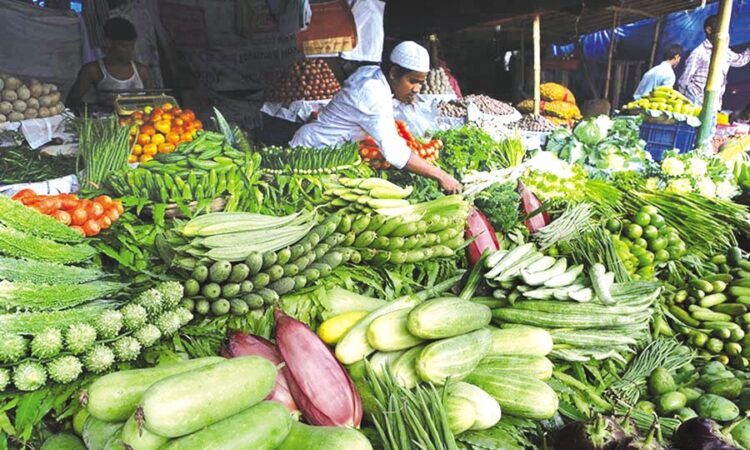
As an expression, cost of living almost always bodes a feeling of concern for common men and women who are in the majority. It sometimes becomes alarming for many of them when the gap between income and expenses for essentials yawns beyond endurance. It then becomes a nightmare that haunts every waking hour of night and day. The peak of Covid-19 pandemic was such a period of panic for the poor and people of low income, ensnaring even the middle income group. No sooner was that nightmarish experience left behind than it has now returned roaring back on the back of record inflation throughout the world. Cost of living as a scourge never had such a long run in recent history.
During the Covid pandemic, cost of living crisis caught every one, except the rich (the fortunate one per cent of population in most countries), by surprise. The poor and the low income groups suddenly became poorer while a significant number of those belonging to the middle class fell below from the income rung of the ladder where they had climbed through hard labour. It made no difference to sufferings and privations whether a country was rich, developed or poor and developing; rising cost of living played havoc everywhere. In America, the unemployed and the low income group made a beeline to the food bank to receive free food packets for days together till the stimulus package of the Federal government bailed them out and that was not too soon, thanks to bi-partisan wrangling in the Congress. In the United Kingdom (UK), the situation was slightly better, firstly because of the lingering benefits of the welfare state, and secondly, by the prompt action by the government in power which was not hamstrung by inter party politics. Similar was the case in the social democracies in Europe where routine social safety net plus emergency relief measures came to the rescue of those who found themselves without income because of the pandemic.
The situation in countries like India and Bangladesh was not so encouraging. Firstly, there is no comprehensive social security system in these two countries, and instead there are a number of programmes for financial help to targeted groups, like the rural employment guarantee scheme in India and various financial assistance projects to help the old, widowed and other disadvantaged groups in Bangladesh. The coverage of these programmes are not comprehensive, leaving out many of the deserving ones, due either to limited budget or faulty enlistment. Secondly, the stimulus programmes announced for providing financial assistance to the poor and low income groups during the pandemic was inadequate and more importantly, was late in disbursement due to administrative procedures like finalising list of beneficiaries. In Bangladesh a total of 28 stimulus packages were announced two months after the first lockdown, with a total of Tk 200.42 billion for different sectors and target groups. Out of this total, 8.0 per cent were allocated for farmers and low income groups amounting to Tk 15.70 billion. It is estimated that 70 per cent of this was disbursed among the poor after the prolonged enlistment procedure was completed. The achievement of target in distributing relief in kind ( rice and wheat) among the poor , at an estimated cost of Tk 2.5 billion, however, was only 4.8 per cent (Bonik Barta,July,2022). According to the same source, distribution of Tk 2500 per head among half a million extreme poor reached 94 per cent of target, which has to be taken with a grain of salt as the list of extreme poor is yet to be completed by Bangladesh Bureau of Statistics and the Ministry of Disaster management even after 5 years of starting enumeration. Ironically, at the same time that the number of poor increased (from 20 per cent to 30 per cent), the number of billionaires in Bangladesh (as elsewhere) increased even at a faster rate than before the pandemic. According to a newspaper, more than ten thousand new billionaires were reported by banks during the calendar year 2020( Jai Jai Din, October,2021).
According to a joint survey conducted by Power and Participation Research Centre (PPRC) and the Brac Institute of Governance and Development (BIGD), the per capita income of urban poor was 13.7 per cent below the pandemic level in March 2021, as opposed to 1.90 per cent in rural areas. Cost of living increase hurt urban poor and low income groups more than the same groups in rural areas. The survey found that even one year after the first lockdown was withdrawn, the majority of families in urban slums were still struggling to make both ends meet. According to the PPRC-BIGD joint survey, per capita daily food expenditure of urban slum households in March 2021 was 16.7 per cent less compared to pre- pandemic level. On the other hand, their non- food expenditures sky- rocketed between June, 2020 and March, 2021. Increase in rent, utilities, health and transportation costs accounted for 98 per cent rise of non-food items.
Cost of living increase caused by the pandemic got a temporary reprieve for about half a year, till June, 2022. In the words of Tom Cark, a columnist of Financial Times (FT): ‘The picture has since moved too rapidly to read. A brief spell of improvement gave away to the wage- cutting chaos of Covid, and then a robust bounce back, which only last autumn emboldened Boris Johnson to boast that ” after years of stagnation, wages are going up.” But in truth rising prices, especially for fuel, were already biting into pay packets’. He concludes: ‘ For the luckier among us, stalling living standard (due to increase in cost of living) are a gloomy reality, but one we can address with care. Those, facing a choice between a dangerous cold and unsustainable debt, do not have that luxury. For them, panic is inevitable, and there is no answer but emergency relief.” The Conservative government has now responded to the rise in cost of living by placing a cap on electricity bill for six months, until after the present winter is over. Other European countries suffering even more from the bite of diminished energy supply, particularly gas, after the Ukraine war, have provided similar relief to their citizens. Unlike the UK and the European Union (EU) countries, America has not been buffeted by energy crisis because of its oil reserves and the rise in cost of living through record inflation there is more due to wage increases and supply chain bottlenecks. The Federal Reserve Bank has sought to restrain inflation through successive increase in basic rate of interest (0.75 per cent each time) and tight money (replacing quantitative easing). It seems the monetary policy change is bearing fruit as the inflation rate has lately come down to 7.8 per cent from a record high of 9.5 per cent six months ago. But this improvement will be at a cost, a deepening recession that is not likely to be transitory. The cost of living of the Americans who will face lower wages and unemployment as result of recession will start to soar. If it is prolonged, monetary policy will have to be complemented by compensatory fiscal policy, a reprise of the pandemic-period stimulus, both for the economy and the distressed consumers.
INFLATION IN BANGLADESH: In Bangladesh, inflation, following the war in Ukraine skyrocketed, as in the rest of the world. But unlike in Europe and America, both food and energy price increases have contributed to headline inflation, raising cost of living for all income groups. As in the past, the poor and low income people have been the hardest hit. The lower estimate of Bangladesh Bureau of Statistics (BBS) showing food inflation at 5.21 per cent in September, 2022 and non-food inflation at 6.19 per cent, though both higher than the 5.50 per cent target projected in the 2022-2023 budget, has been called into question by many for underrating the actual rise in prices, particularly for food items. According to critics of BBS, headline inflation for both food and non-food items went above 8 per cent before coming down in recent weeks.
According to Consumer Association of Bangladesh (CAB),compared to international market, price increases of essential items in Bangladesh have been higher due to lax control of syndicates’ manipulation in the markets of various items by concerned authorities. Even after making allowance for sharp spike in prices in international market, the runaway price regimes in local markets for food items do not appear justified. For this unrestrained market behaviour the machinations of middlemen and organised cartels (syndicates) operating with impunity is blamed.
It is estimated by CAB that more than 70 per cent of income of low income earners are spent by them to buy food items. Those without sufficient income to do this, are reducing their food purchase undergoing almost chronic malnutrition. This view has been corroborated by others, including PPRC, BIGD and Centre for Policy Dialogue (CPD). This coping strategy to somehow survive the cost of living crisis was seen at its worst during the pandemic.
According to a newspaper report, in the 60 Upazilas where the poverty rate is above 30 per cent, the government is considering taking up special relief measures, like food for works programme. Bringing more disadvantaged people within the ambit of the existing social safety net programmes is also on the cards. If the economic distress of the poor and low income people becomes more critical government may provide cash assistance to the ultra poor and low income earners, as was done during Covid, it has been reported ( Bonik Barta,11 August,2022).
To temper unusual increases in prices of food items, government uses the Trading Corporation of Bangladesh (TCB) for open market operation, selling food items at subsidised prices. This was resorted to with a great deal of urgency during pandemic, compromising the social distancing regulation as buyers lined up in droves behind TCB trucks on streets. In view of the alarming increase in prices of food items in recent months government decided to sell food items from March 2022 among low income families for which ‘family cards’ have been issued. Card holders can now buy subsidised food items from designated dealers in their locality, instead of queuing behind distributing trucks. But in the absence of the list of poor families, it is doubtful if deserving families will benefit from this initiative, analysts have observed. Moreover favouritism on political consideration may frustrate the objectives of the programme (Amader Somoy, 20 March, 2022). According to CAAB, purchasing food items from local market for distribution among card holders will not stabilise the market and therefore food items should be procured through imports.
In capital city, TCB started selling food items from trucks since March this year in every ward among card holders. But as cards have been issued by local councillors of the respective wards of the city corporations only to local residents, the large number of floating population has not been able to benefit from this programme. According to Transparency International, Bangladesh (TIB), about 39.5 per cent of local resident families in wards have not received cards. Realising this loophole, TCB is now selling from trucks to buyers on first come first basis, leaving open the scope for misuse on the ground. Scuffles and altercations among buyers waiting to buy from TCB trucks have become daily common scenes. In view of the various difficulties in distribution, both through TCB of the Commerce Ministry and the Open Market System (OMS) of the Ministry of Food, the demand for restoring the old rationing system has been gaining ground. It seems reasonable and desirable to combine both the distribution and sales systems and start selling essential food items through ration shops. But to make it successful the dilatory enlistment programme covering poor families, undertaken by BBS and the Ministry of Disaster Management, should be expedited so that ration cards can be issued among the deserving families. It may be pointed out that when Bangladesh discontinued with the rationing system in 1990 under pressure from World Bank, International Monetary Fund (IMF) etc., India expanded this relic of the British era, giving it the moniker of ‘Adhar’ to include financial assistance during emergencies along with essential food items in normal times. This has been widely appreciated as one of the most successful social security programme in the world. It is high time that Bangladesh re-introduced this time- tested programme of social security, inserting new components.
END NOTE: Since cost of living can be expected to be always above the regular income of the poor and low income groups, in addition to the disadvantaged and the old, a strong case can be made out for a comprehensive social security programme, covering provision of essential food items in ration shops, free healthcare in government hospitals and pension in old age. Now some of these are being provided in a piece meal fashion and some only as emergency measures. The recent announcement by the government to introduce contributory universal pension scheme is very commendable in as much as it recognises the obligation of the government to care for citizens, both when they are income earners and or old and retired. But to be ‘universal ‘everyone has to be covered under this and this is not feasible in view of the present fiscal space (only 2 per cent of GDP being spent for various social safety net programmes in Bangladesh as against 20 per cent in Europe). Therefore, a gradualist approach has to be made, taking the poor and low income groups first as the participants of the pension scheme where government contribution will need to be higher than that from the beneficiaries. But to be really a social security system this scheme should be broadened in scope to include heath care and unemployment benefit, in addition to pension in old age. In other words, Bangladesh should be bold and ambitious enough to take the first step towards becoming a twenty first century ‘ welfare state, a much maligned word for quite some time. A step by step approach rather than a giant step forward is envisaged in this regard. An essential component to make it participatory will require monthly contributions from the beneficiary groups of poor and low income earners (including beggars) both to engender a sense of ownership and to ensure sustainability.
Of the various benefits under social security, unemployment assistance has usually come under heavy criticism for alleged misuse and ‘welfare dependency’. The criticism has not been totally misplaced and unwarranted as evidences across countries where this component has been made available under social security have attested. But everywhere it has been the minority among the unemployed who have become ‘welfare dependent’ and have abused the system. Social justice, John Rawls said, should not be determined by the aberrations of the few. When cost of living threatens to rend the social fabric asunder much should not be made of possible risks. After all, risk management is part of governance. Besides, a family does not disown and throw out one of its member because it is a problem child. But for this touch of compassion, humans would be no different from animals.
hasnat.hye5@gmail.com


